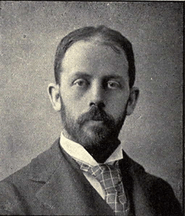Asaph Hall Jr.
| Asaph Hall Jr. | |
|---|---|
|
Hall from the 1902 Michiganensian | |
| Born |
October 6, 1859 Cambridge, Massachusetts, USA |
| Died | January 12, 1930 (aged 70) |
| Residence | United States |
| Nationality | United States |
| Fields | Astronomy |
| Institutions | U. S. Naval Observatory, University of Michigan |
| Alma mater | Harvard University, Yale University |
Asaph Hall Jr. (October 6, 1859 – January 12, 1930) was an American astronomer. He was the son of Asaph Hall, who discovered the moons of the planet Mars. One of his brothers was Percival Hall.
Early life and education
Hall was born in Cambridge, Massachusetts in 1859. He was the son of the astronomer Asaph Hall and the mathematician Angeline Stickney Hall.[1] He grew up in Washington, DC where his father worked at the United States Naval Observatory. He attended the Columbian College in the District of Columbia (now George Washington University) and then Harvard University, where he received his undergraduate degree in 1882.[2]
After graduation Hall became an assistant at the Naval Observatory. In 1885 he went to Yale University as a graduate student and an assistant at Yale Observatory. Because of a large difference between his father's measurement of the mass of Saturn at the Naval Observatory and that of Friedrich Bessel in Germany,[3] Hall used the Yale heliometer to determine the mass of Saturn using the orbit of Titan.[4] His results confirmed Bessel's measurement. He received his Ph.D. in 1889.[2]
Subsequent career
After receiving his doctorate from Yale, Hall returned to the Naval Observatory as assistant astronomer. In 1892 he went to the University of Michigan in Ann Arbor as professor of astronomy and director of the Detroit Observatory.[5] There he repaired the meridian circle and used it to do a determination of the constant of aberration.[6][7]
In 1897 he married Mary Estella Cockrell. They had two daughters, Mary and Katherine.[2]
In 1905 he returned to the Naval Observatory, and became professor of Mathematics at the rank of commander in the Navy in 1908. There he worked on the orbits of planetary satellites[8] using the 26-inch (66-cm) telescope, the great refractor of his father's discoveries. He retired in 1929 and died the following year. He is buried in Arlington National Cemetery.[2] His career is used as an example in John Lankford's study of the sociology of astronomy.[9]
References
- ↑ Carter, Mary Sue. "Chloe Angeline Stickney Hall". The Contributions of Women to the United States Naval Observatory: The Early Years. Retrieved 2 April 2012.
- 1 2 3 4 Olivier, Charles P. (1930). "Asaph Hall". Popular Astronomy. 38: 531–533. Bibcode:1930PA.....38..531O.
- ↑ "Determination of the mass of Saturn from observations of Titan with the Yale heliometer". Monthly Notices of the Royal Astronomical Society. 51: 249. February 1891. Bibcode:1891MNRAS..51..249.. doi:10.1093/mnras/51.4.237.
- ↑ Hall, Asaph Jr. (1889). "Determination of the orbit of Titan and the mass of Saturn". Transactions of the Astronomical Observatory of Yale University. 1, Part II: 107–148. Bibcode:1887TOYal...1..107H.
- ↑ Snyder, Dave (2002). "The History of the Detroit Observatory". University Lowbrow Astronomers. Retrieved 2 April 2012.
- ↑ Hall, Asaph Jr. (1902). "Aberration constant from zenith distances of Polaris". Astronomical Journal. 22 (518): 109–113. Bibcode:1902AJ.....22..109H. doi:10.1086/103376.
- ↑ Hall, Asaph Jr. (1904). "Determination of the Aberration Constant from the Zenith Distances of Polaris, Measured with the Walker Meridian Circle". Fourth Report of the Michigan Academy of Science: 35–88. Retrieved 2 April 2012.
- ↑ "Equatorial Observations, 1908–1926". Publications of the U.S. Naval Observatory Second Series. 12: 3–79. 1929. Bibcode:1929PUSNO..12....3.. doi:10.5479/ADS/bib/1929PUSNO.12.3.
- ↑ Lankford, John; Ricky L. Slavings (1997). American Astronomy: Community, Careers, and Power, 1859–1940. University of Chicago Press. pp. 99, 127. ISBN 0226468860. Retrieved 2013-04-07.
